Abstract
Four rats were exposed to variable-interval schedules specifying a range of different reinforcement frequencies. The effects of two doses of d-amphetamine (1.6 and 3.2 mumol/kg) upon performance maintained under each schedule were examined. In the case of each rat, the response rates observed under control conditions (no injection or injection of the vehicle alone) were increasing, negatively accelerated functions of reinforcement frequency, the data conforming closely to Herrnstein's (1970) equation. In each rat, d-amphetamine (3.2 mumol/kg) significantly reduced the value of the constant Rmax, which expresses the theoretical maximum response rate. In each rat, the value of KH, which expresses the reinforcement frequency needed to obtain the half-maximal response rate, was also reduced, although this only achieved statistical significance in the case of one rat. When the proportional change in response rate in the presence of the drug was plotted against the response rate under control conditions on double logarithmic co-ordinates, linear functions of negative slope were obtained; in each rat the slope was steeper and the value of the control response rate at which d-amphetamine exerted no effect was lower in the case of the higher dose (3.2 mumol/kg) than in the case of the lower dose (1.6 mumol/kg).
Full text
PDF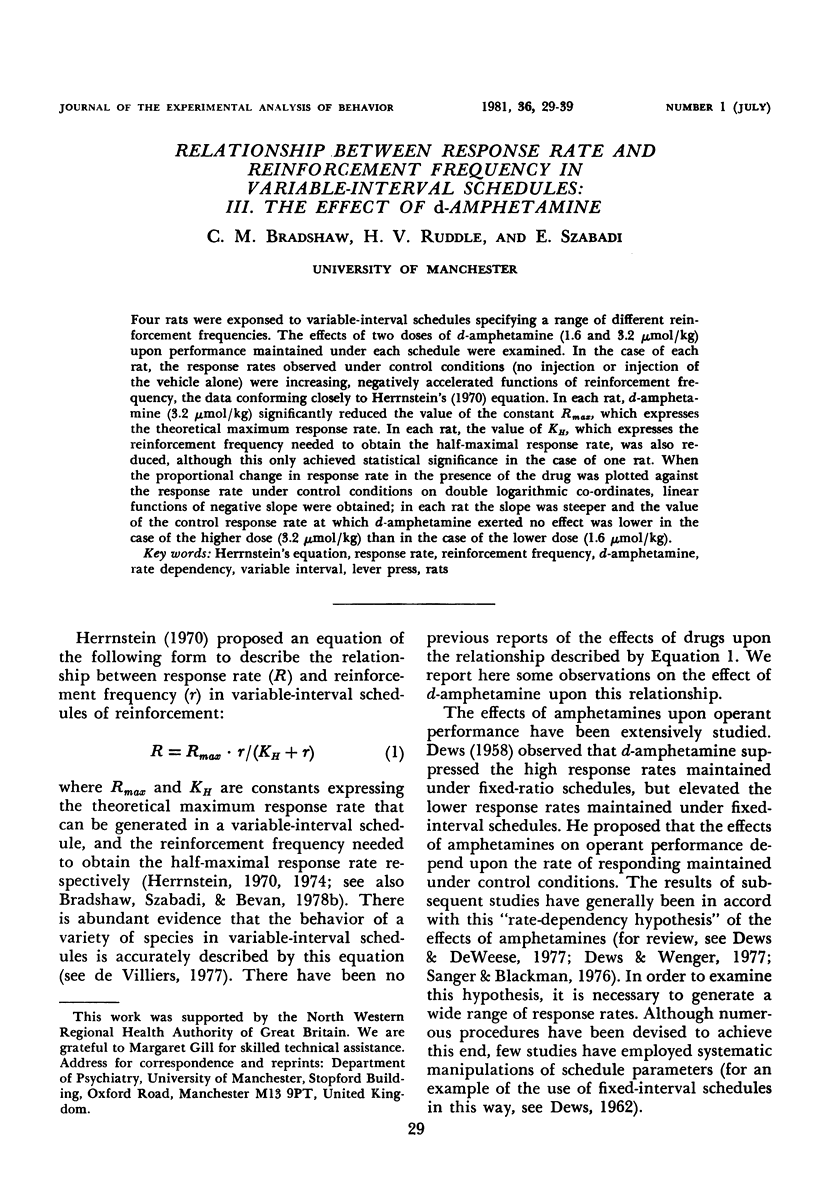
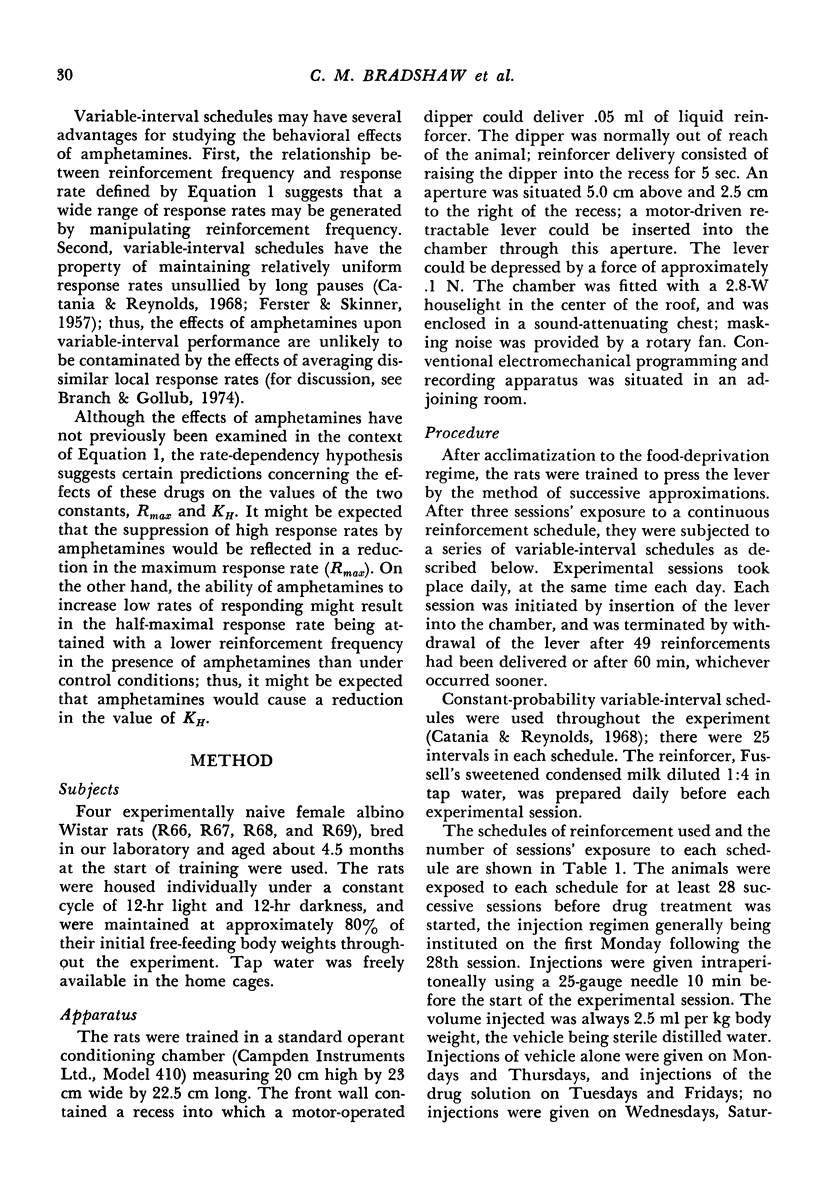
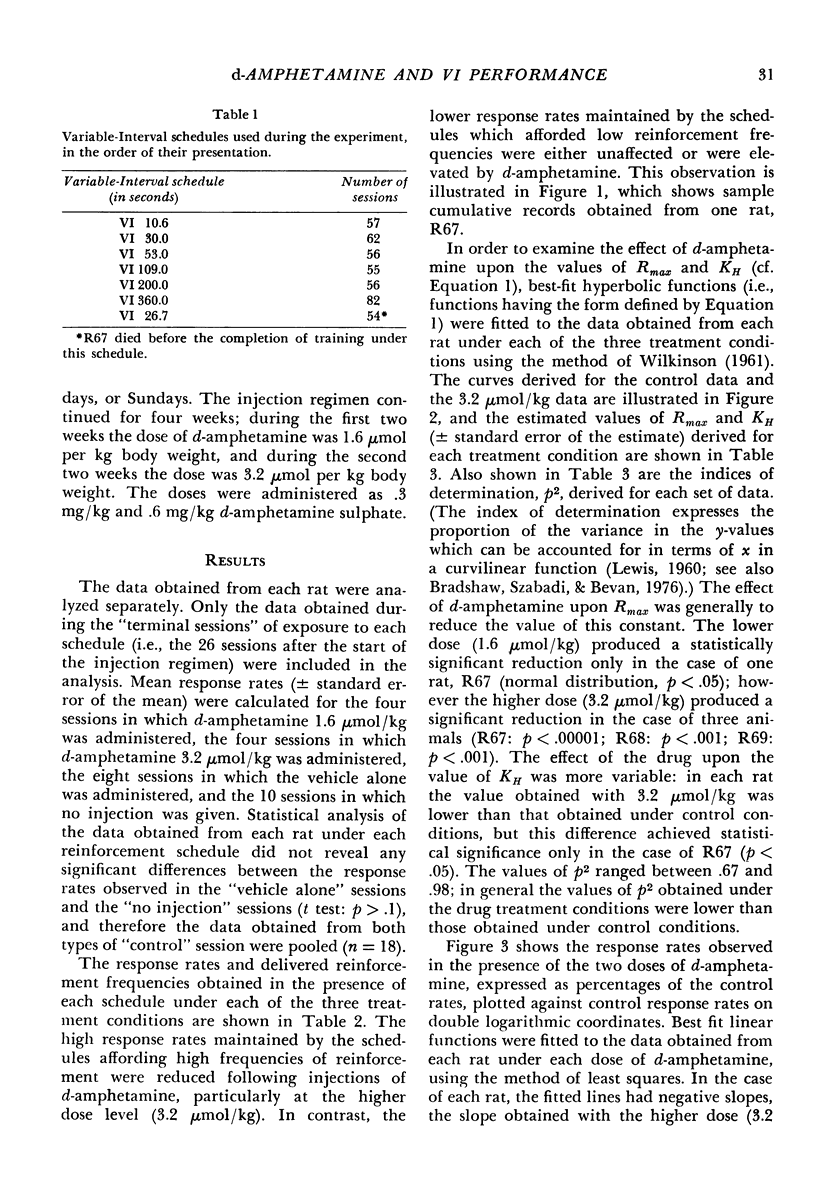
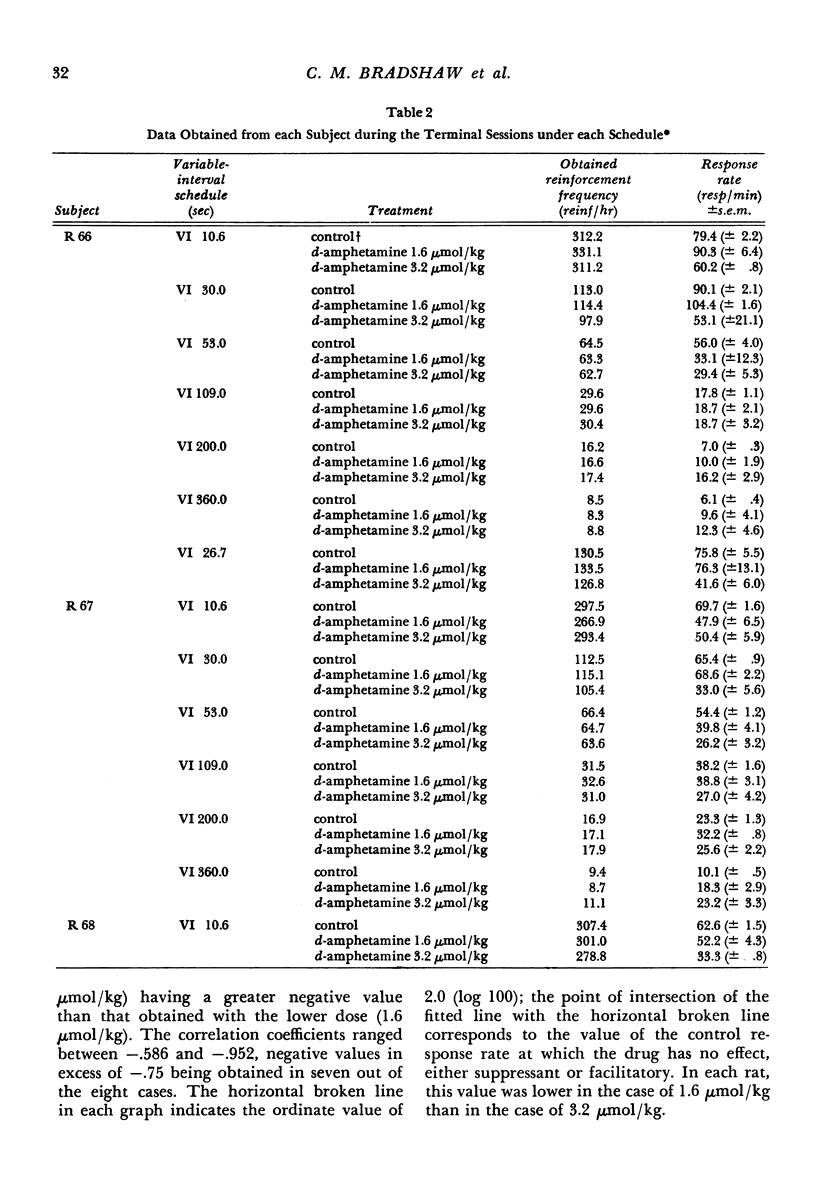
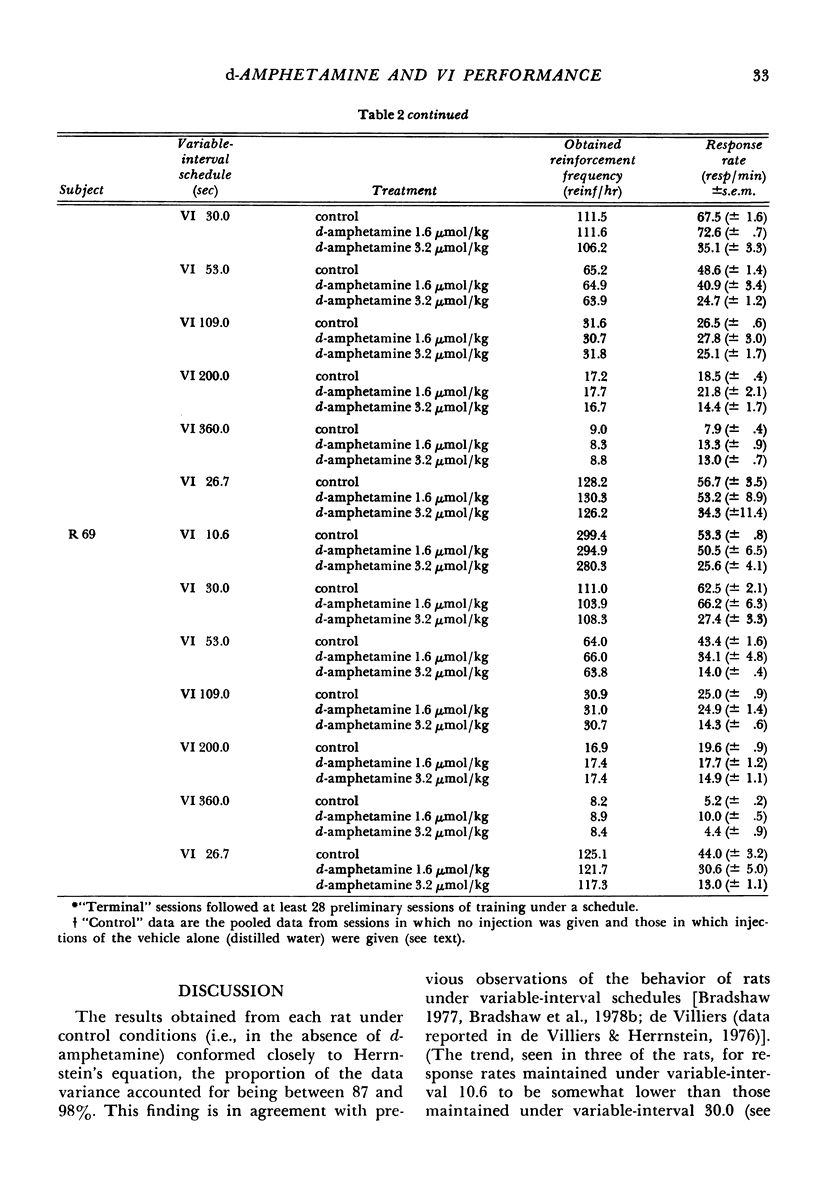
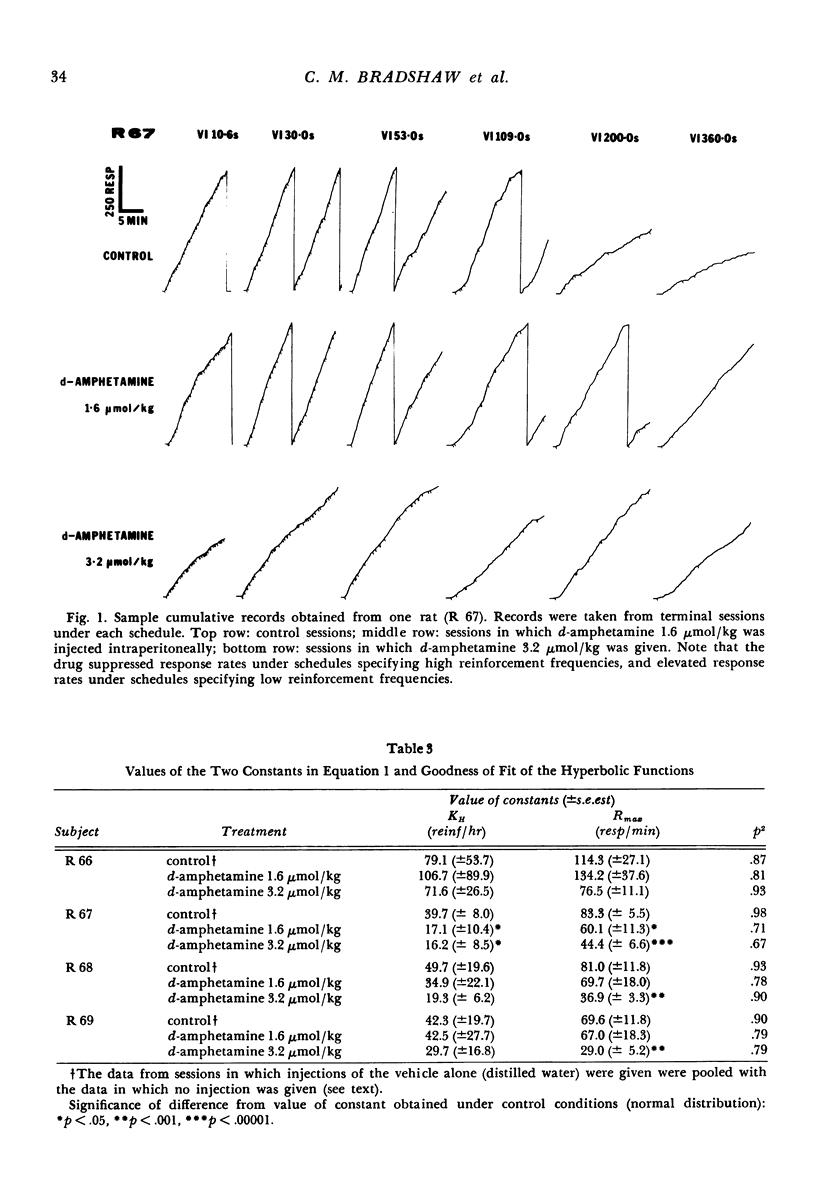
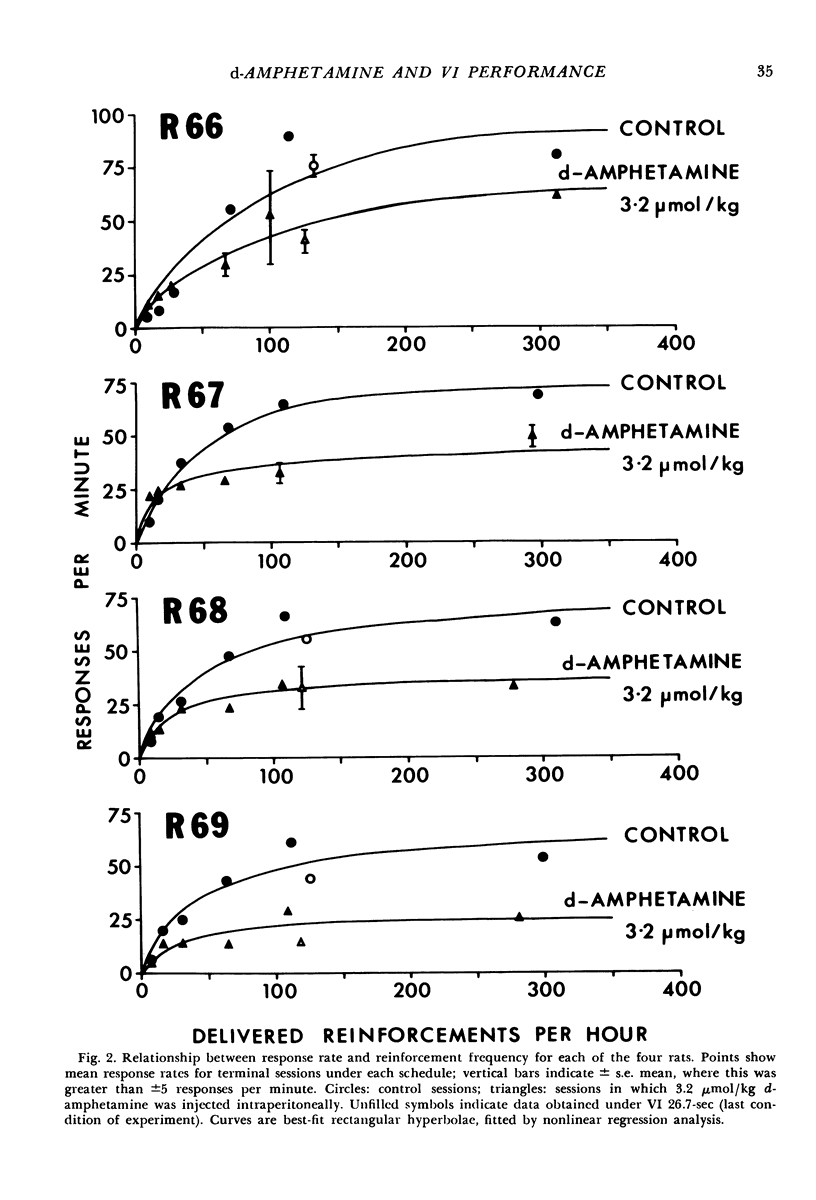
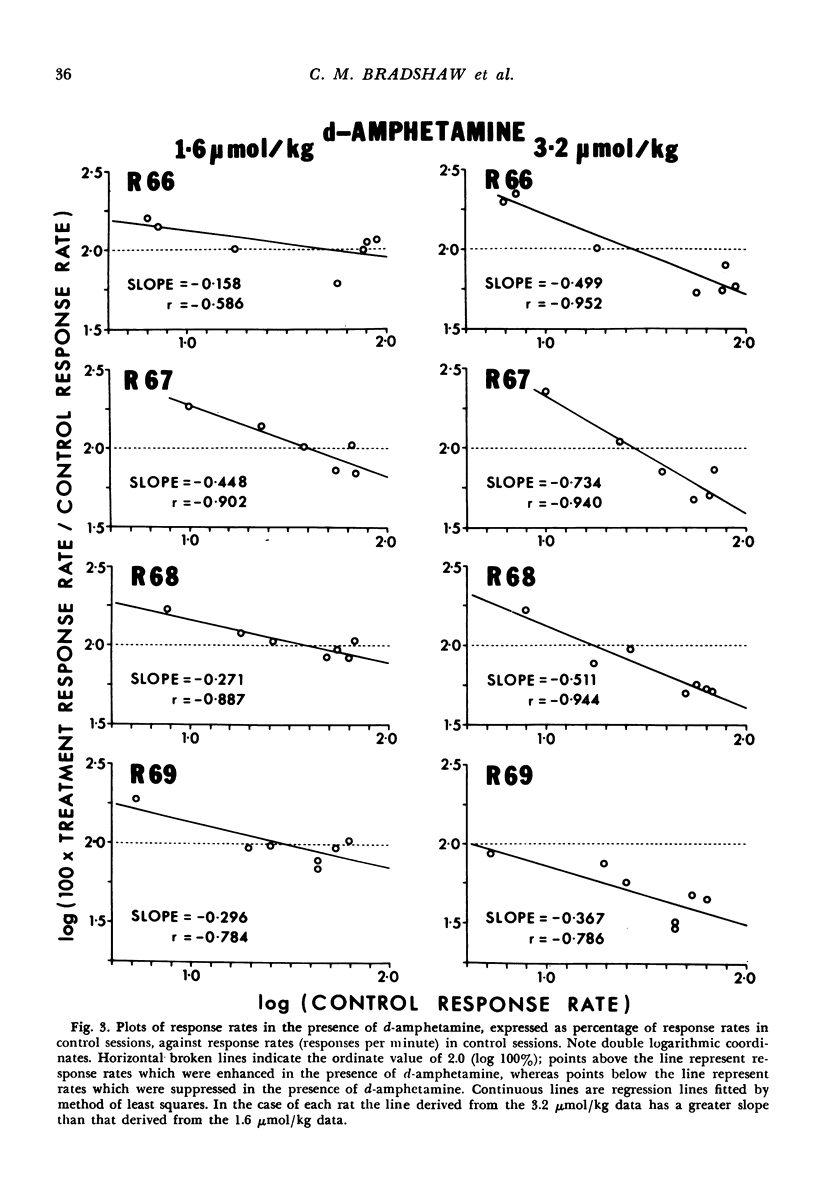
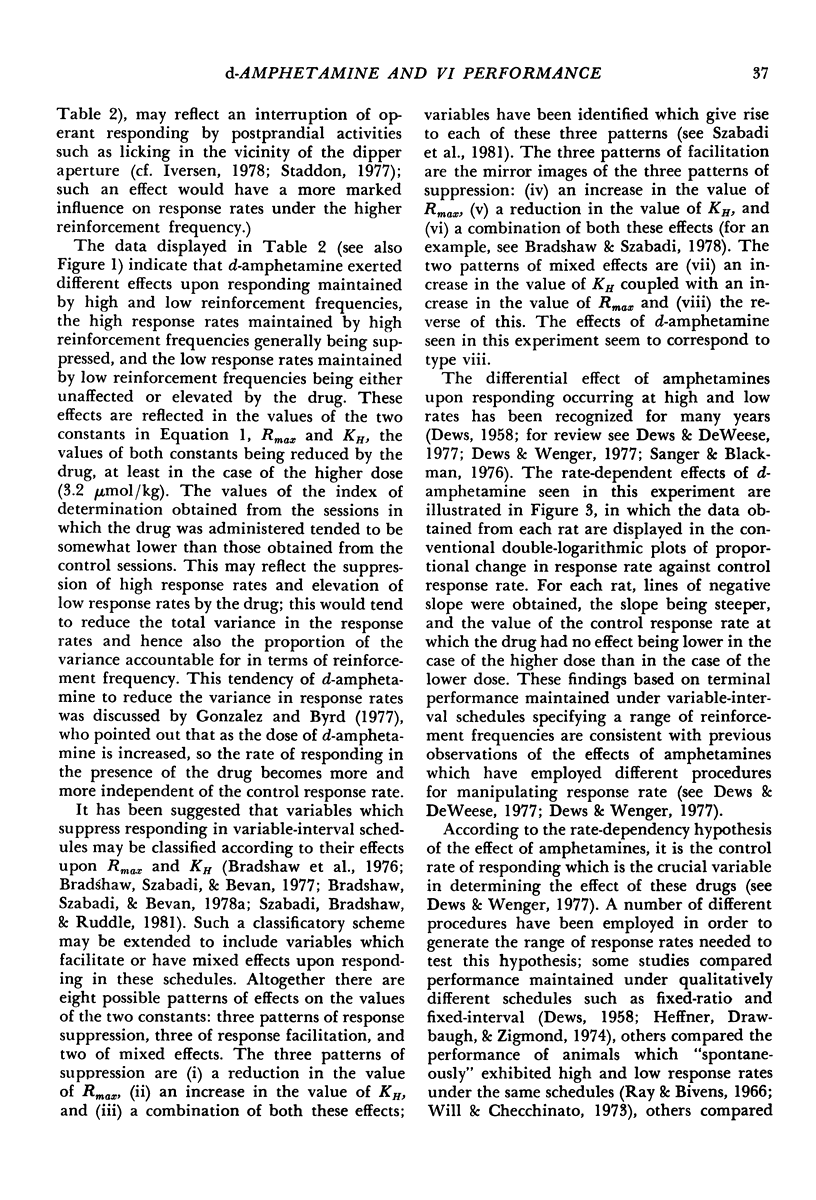
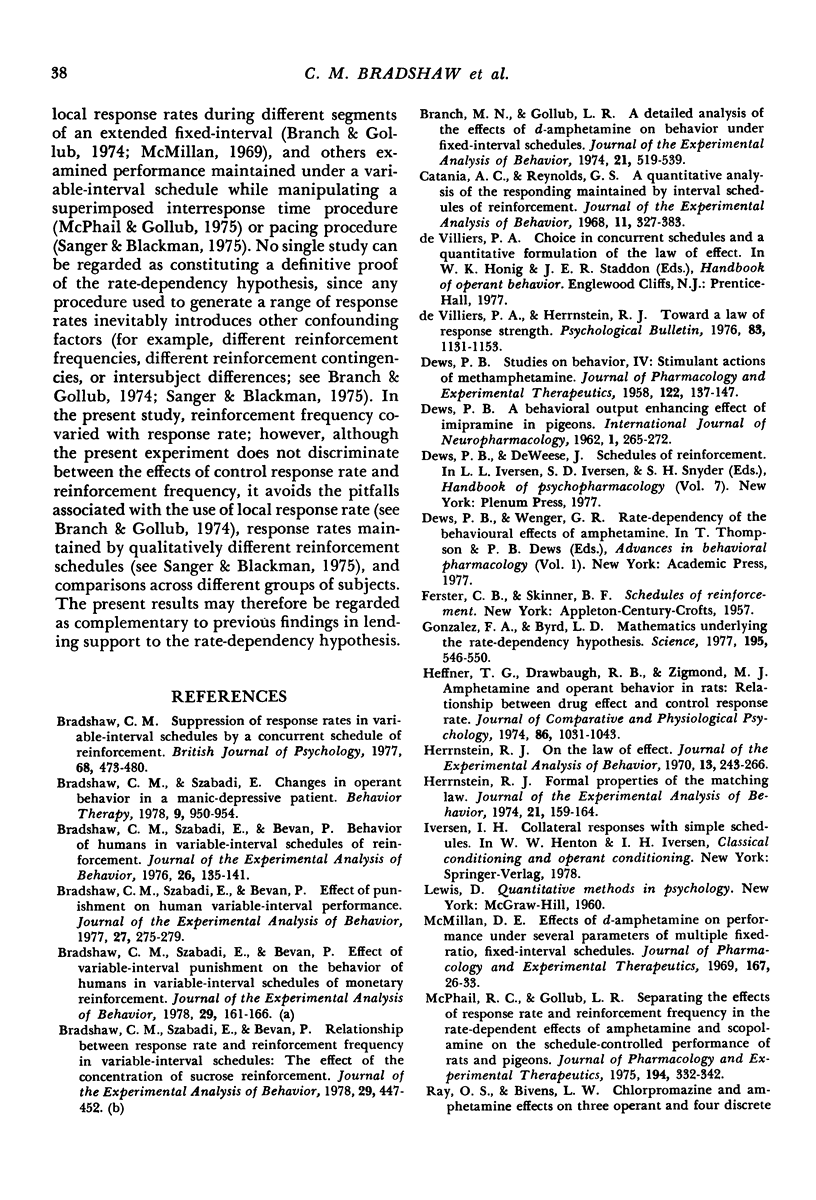
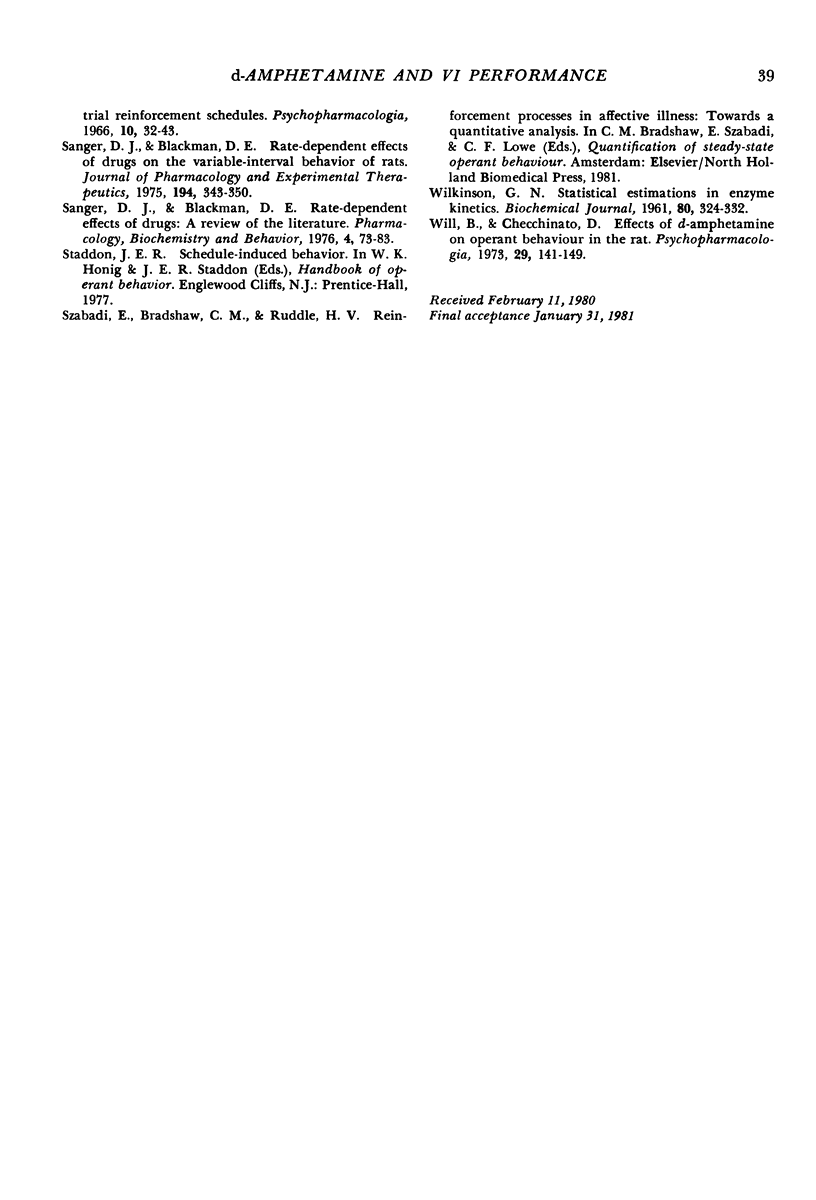
Selected References
These references are in PubMed. This may not be the complete list of references from this article.
- Bradshaw C. M., Szabadi E., Bevan P. Behavior of humans in variable-interval schedules of reinforcement. J Exp Anal Behav. 1976 Sep;26(2):135–141. doi: 10.1901/jeab.1976.26-135. [DOI] [PMC free article] [PubMed] [Google Scholar]
- Bradshaw C. M., Szabadi E., Bevan P. Effect of punishment on human variable-interval performance. J Exp Anal Behav. 1977 Mar;27(2):275–279. doi: 10.1901/jeab.1977.27-275. [DOI] [PMC free article] [PubMed] [Google Scholar]
- Bradshaw C. M., Szabadi E., Bevan P. Effect of variable-interval punishment on the behavior of humans in variable-interval schedules of monetary reinforcement. J Exp Anal Behav. 1978 Mar;29(2):161–166. doi: 10.1901/jeab.1978.29-161. [DOI] [PMC free article] [PubMed] [Google Scholar]
- Bradshaw C. M., Szabadi E., Bevan P. Relationship between response rate and reinforcement frequency in variable-interval schedules: the effect of the concentration of sucrose reinforcement. J Exp Anal Behav. 1978 May;29(3):447–452. doi: 10.1901/jeab.1978.29-447. [DOI] [PMC free article] [PubMed] [Google Scholar]
- Branch M. N., Gollub L. R. A detailed analysis of the effects of d-amphetamine on behavior under fixed-interval schedules. J Exp Anal Behav. 1974 May;21(3):519–539. doi: 10.1901/jeab.1974.21-519. [DOI] [PMC free article] [PubMed] [Google Scholar]
- Catania A. C., Reynolds G. S. A quantitative analysis of the responding maintained by interval schedules of reinforcement. J Exp Anal Behav. 1968 May;11(3 Suppl):327–383. doi: 10.1901/jeab.1968.11-s327. [DOI] [PMC free article] [PubMed] [Google Scholar]
- DEWS P. B. Studies on behavior. IV. Stimulant actions of methamphetamine. J Pharmacol Exp Ther. 1958 Jan;122(1):137–147. [PubMed] [Google Scholar]
- Gonzalez F. A., Byrd L. D. Mathematics underlying the rate-dependency hypothesis. Science. 1977 Feb 11;195(4278):546–550. doi: 10.1126/science.402028. [DOI] [PubMed] [Google Scholar]
- Heffner T. G., Drawbaugh R. B., Zigmond M. J. Amphetamine and operant behavior in rats: relationship between drug effect and control response rate. J Comp Physiol Psychol. 1974 Jun;86(6):1031–1043. doi: 10.1037/h0037634. [DOI] [PubMed] [Google Scholar]
- Herrnstein R. J. Formal properties of the matching law. J Exp Anal Behav. 1974 Jan;21(1):159–164. doi: 10.1901/jeab.1974.21-159. [DOI] [PMC free article] [PubMed] [Google Scholar]
- Herrnstein R. J. On the law of effect. J Exp Anal Behav. 1970 Mar;13(2):243–266. doi: 10.1901/jeab.1970.13-243. [DOI] [PMC free article] [PubMed] [Google Scholar]
- MacPhail R. C., Gollub L. R. Separating the effects of response rate and reinforcement frequency in the rate-dependent effects of amphetamine and scopolamine on the schedule-controlled performance of rats and pigeons. J Pharmacol Exp Ther. 1975 Aug;194(2):332–342. [PubMed] [Google Scholar]
- McMillan D. E. Effects of d-amphetamine on performance under several parameters of multiple fixed-ratio, fixed-interval schedules. J Pharmacol Exp Ther. 1969 May;167(1):26–33. [PubMed] [Google Scholar]
- Ray O. S., Bivens L. W. Chlorpromazine and amphetamine effects on three operant and on four discrete trial reinforcement schedules. Psychopharmacologia. 1966;10(1):32–43. doi: 10.1007/BF00401897. [DOI] [PubMed] [Google Scholar]
- Sanger D. J., Blackman D. E. Rate-dependent effects of drugs on the variable-interval behavior of rats. J Pharmacol Exp Ther. 1975 Aug;194(2):343–350. [PubMed] [Google Scholar]
- Sanger D. J., Blackman D. E. Rate-dependent effects of drugs: a review of the literature. Pharmacol Biochem Behav. 1976 Jan;4(1):73–83. doi: 10.1016/0091-3057(76)90178-7. [DOI] [PubMed] [Google Scholar]
- WILKINSON G. N. Statistical estimations in enzyme kinetics. Biochem J. 1961 Aug;80:324–332. doi: 10.1042/bj0800324. [DOI] [PMC free article] [PubMed] [Google Scholar]
- Will B., Checchinato D. Effects of d-amphetamine on operant behaviour in the rat. Psychopharmacologia. 1973 Mar 16;29(2):141–149. doi: 10.1007/BF00422646. [DOI] [PubMed] [Google Scholar]


